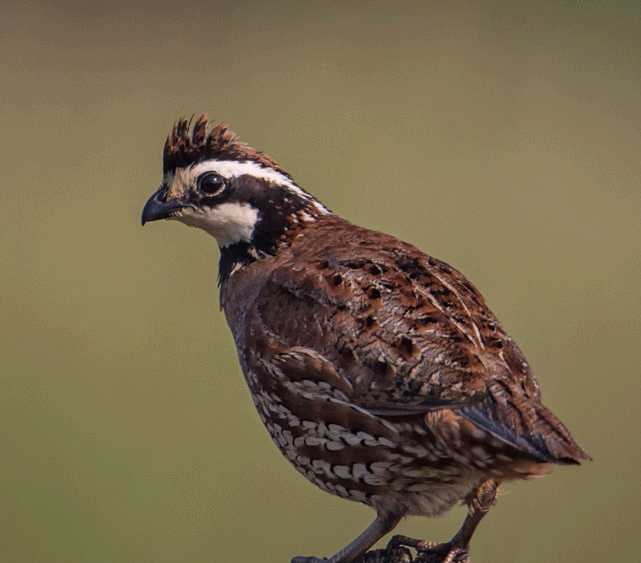SCIENTIFIC NAME:
Colinus virginianus
STATUS:
Breeder. Fairly common to uncommon and declining in all seasons and regions. MODERATE CONSERVATION CONCERN.
DESCRIPTION:
The northern bobwhite belongs to the order Galliformes, which is from the Latin gallinaceus meaning “of poultry.” They are in the same order of birds as domestic fowl, which also includes turkeys, pheasants, grouse, partridges and other quail. It is part of the family Odontophoridae, the New World quails which have a serrated lower mandible. The genus name Colinus derives from an Aztec word meaning quail. There are four species of Colinus (bobwhites) in North, Central, and South America. Only the northern bobwhite, Colinus virginianus, occurs in the United States.
The bobwhite’s common name derives from the sound of the male’s breeding call – a two or three note whistle that sounds like bob-white or ah-bob-white. The first syllables are low monotones, followed by the final resounding, rising note.
Male bobwhites have a white feathered throat patch and eye stripe bordered with black. On females, these areas are a deep buff color. The crown of the head, neck, upper breast, upper back and wing coverts are russet. Many of the feathers are barred on the edge with black or gray. The nape and upper breast are streaked with white and the tail is gray. The abdomen is white or buffy white with black barring and tawny striping on the flanks. The beak is black and legs are tannish gray.
Adults are about eight inches in length. Average weights vary from a little less than six ounces for birds from warm southern climates to slightly more than seven ounces for birds from the colder northern portions of its range. Alabama bobwhites average about six ounces.
DISTRIBUTION:
Bobwhites have an extensive range, from southeastern New York to southern Ontario, west to south central South Dakota, eastern Wyoming, eastern Colorado, eastern New Mexico, and south through the Gulf States and most of Mexico and Central America. Introduced to the Pacific Northwest, scattered populations still exist in valleys along tributaries of the Snake and Columbia rivers in Idaho, Oregon, Washington, Montana, and British Columbia. Also, the masked bobwhite (Colinus virginianus ridgwayi), an endangered subspecies, has been reintroduced to southern Arizona. Introduced populations of bobwhites also occur in Cuba, Haiti, the Dominican Republic, and New Zealand.
HABITAT:
Adapted to habitats dominated by forbs (annual broad-leafed herbaceous plants) transitioning to native perennial bunchgrasses and scattered brush. They are found in abandoned weedy fields and open pinelands or savanna with extensive groundcover of forbs, native grasses, and scattered brush thickets.
FEEDING HABITS:
The winter diet of bobwhites consists mostly of weed seeds picked up from the ground. Consequently, they need seed-bearing plants that drop their seed onto relatively bare ground where it can be easily seen or scratched. During spring many sprouting seeds are eaten, and in summer maturing seeds are often taken directly from plants. Insects (beetles, true bugs, and small grasshoppers) are a major food item during summer, especially for growing chicks that require a high protein diet.
LIFE HISTORY:
During winter, bobwhites live in a covey, a group of 12 to 18 individuals. The covey moves and feeds together on the ground during the morning and again in late afternoon in weedy covers where seeds are abundant. The middle of the day is spent loafing in shrub thickets. The covey roosts on the ground in tall grass at night, forming a tight circle to conserve heat. The birds sit with tails touching, sides pressed together, heads to the outside, prepared to instantly burst into flight if threatened.
Coveys separate in spring when breeding begins. The “bob-white” calls of the breeding males begin, usually in mid-April, and may be heard throughout the summer. Bobwhites exhibit a variety of mating systems. The female may pair with one male, and they may remain together during the nesting season. Some females mate and lay a clutch of eggs that are incubated by the male. The hen may then lay and incubate another clutch alone, or mate and produce a nest with another male.
Bobwhites build nests on the ground, often at the base of a clump of broomsedge, using the dead grass blades to construct the nest. Nests average 14 eggs, which hatch after 24 days of incubation. Most nests hatch in mid to late June and into July. Newly hatched chicks leave the nest with the parent bird within a few hours of hatching. At three to five weeks of age, quail broods are capable of surviving independently of parents. At eight weeks, hens and cocks (males) are identifiable by their respective buff or white and black throat patch. The birds are fully grown by the age of 21 weeks. As autumn approaches the birds assemble into coveys for the winter months.
REFERENCES:
Rosene, W. 1969. The Bobwhite Quail, Its Life and Management. Rutgers University Press, New Brunswick, NJ, 418pp.
Stewart, S. 2005. Ecology and Management of the Bobwhite Quail in Alabama. Alabama Department of Conservation and Natural Resources, Montgomery, 47pp.
Stoddard, H. L. 1931. The Bobwhite Quail, Its Habits, Preservation and Increase. Charles Scribner’s Sons, New York, 559pp.
Author:
Stan Stewart, Wildlife Biologist, Division of Wildlife and Freshwater Fisheries






